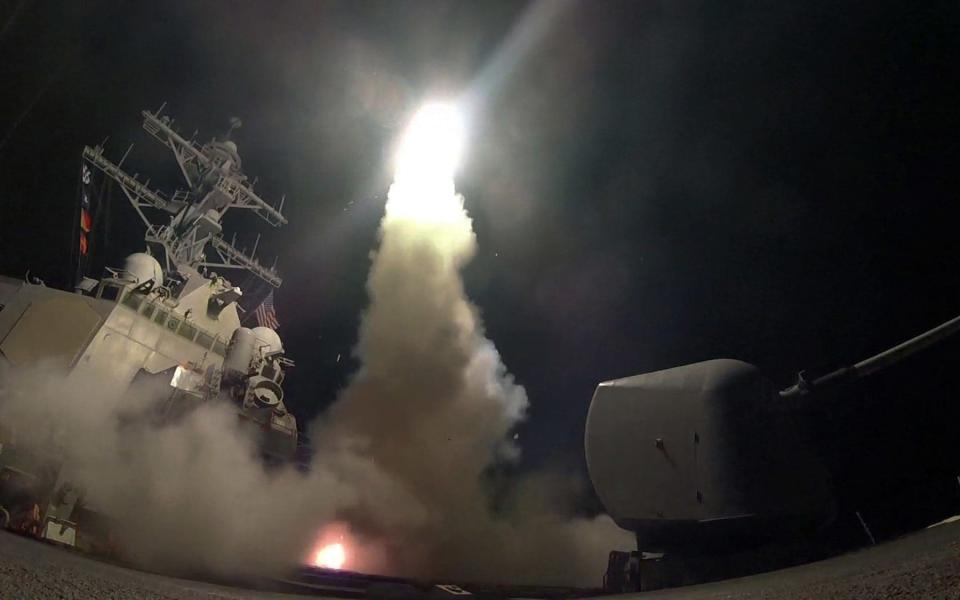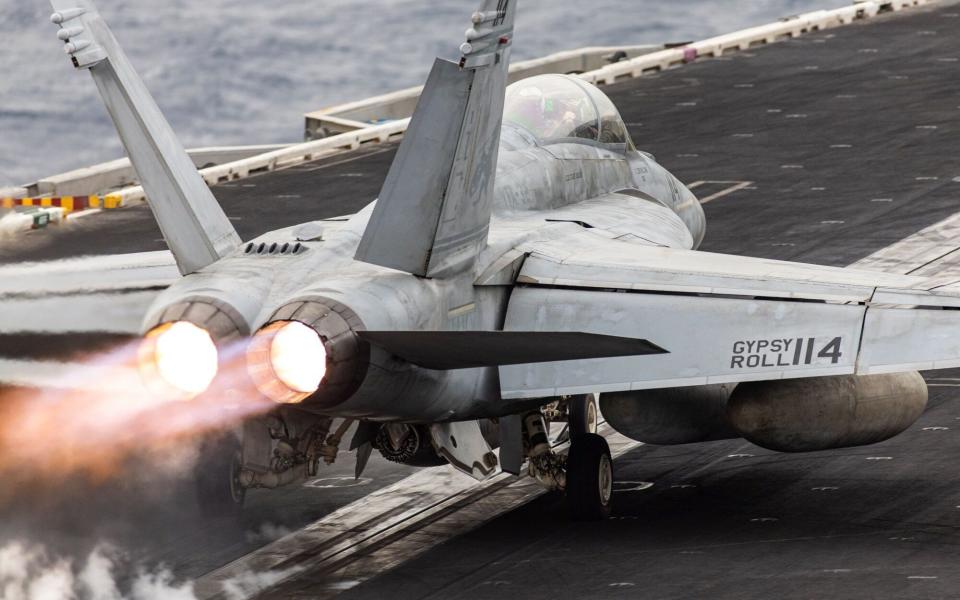Britain is getting ready for war. It’s time to cram our ships with American weapons
This week’s Prime Ministerial announcement on an increase in defence spending was interesting on a number of levels. As all the new money for British defence (as opposed to Ukraine aid) is supposed to arrive post election, and Labour has refused to back the plan, there has to be a large chance the cash will not appear. Even if it does, there are a lot of different ways to look at the pledges. The actual amount available to spend after dealing with the various ongoing disasters and cost overruns is by no means clear.
But let’s be optimistic and say that a substantial sum of extra money could turn up. How should it be spent?
I would say that first and foremost the top priority has to be our service people, including various vital civilian communities such as the Royal Fleet Auxiliary and our nuclear submarine builders and maintainers. The first action needs to be pay rises, focused heavily on junior personnel in the case of the services. The second action needs to be sorting out the utter mess recruitment is in. Then, and this is still time critical, the other factors such as housing, terms, culture etc must be gripped. Those leading this push need to be empowered to make actual changes, bulldozing through entrenched and single-service views if necessary, and they need to stay in post until the situation improves – or suffer the consequences if it does not.
On procurement, a senior minister said to me recently, “Defence can’t have more money until it can be trusted to spend it properly”. While I said at the time I thought this was language more suited to managing a child’s pocket money than the defence of the realm, that particular stick remains in use and will continue to be. Fixing procurement is probably even harder than fixing the personnel issue because there are so many organisations and companies with a vested interest in not doing so.
It’s also unfair to place all the blame for our broken procurement on the 12,000+ bureaucrats of Defence Equipment & Support, or even on Defence ministers in many cases. Major procurement decisions are actually made by the Prime Minister, sometimes on the back of skewed information, but either way the buck stops in No.10.
So what’s to be done?
If you want excellent equipment quickly – and I would suggest that we do – then buying off the shelf from the US is often a good place to start. It isn’t a panacea and must always be balanced against the need to develop our own systems but they invariably take ages, cost a lot, have been known to be unimpressive in capability terms and are seldom quite as sovereign as we would like to think.
So let’s think about things we could just buy that would make a difference. From a naval perspective, we should banish forever the curse of ‘fitted for but not with’ – the necessity, caused by lack of funds, for ships to be designed to carry all sorts of weapons but supplied without them: one classic example being the Type 45 destroyers, which have an empty space – used as a gym – where there ought to be land-attack missiles.
We can deal with this by some purchases across the pond. A future Type 26 frigate with its Mk41 vertical launch system stuffed full of Tomahawk land attack cruise missiles, SM-3s and SM-6s for air and ballistic/hypersonic missile defence and some torpedo-carrying, submarine-killing ASROCs would be a world beater. One with missile tubes filled with loo roll would not.

Still on the subject of frigates – always dear to my heart – there’s the matter of the helicopter to go on the back. This is actually one of the cases where the British kit is the best there is: our Merlin HM2s are like having another frigate which can fly working with you. The Americans do gain an advantage by having two helicopters on each ship, but I would still go with the Merlin. What I would not go with, if there was any sort of submarine threat, is the comparatively unimpressive Lynx Wildcat. As there aren’t enough Merlins to go around at present, we should spend some of the new money refurbishing and bringing up to spec the dozen that were mothballed back in the ’teens.
Moving on to the carriers, the sums of money required to improve this capability are vast but this is a blank sheet exercise so bear with me.
First and foremost we should buy the electromagnetic catapults and arrester wires that the Americans developed for their latest carrier, the Gerald R Ford. Our carriers were designed from the start so that they could have electric catapults fitted at any point in their lives. However, if you discuss ‘cats and traps’ these days people think you have gone mad. Is this a mindset that should now be adjusted?
If you could swallow the initial cost then catapult aircraft are cheaper to buy and operate and we would therefore end up with more. We currently have 34 F-35B jump jets and given the slow purchase rate and pilot qualification issues, it isn’t clear when, if ever, we will have enough to operationally deploy with 36, the number the carrier was designed for.
Catapult carriers fix this because we could then get tailhook jets, starting with the F-18 Hornet, still the main jet of the US Navy and many other air arms and very capable and affordable. These would get us some mass cheaply and quickly. We would gradually introduce F-35C fifth-gen tailhook planes in due course, as the US Navy is doing. The RAF would like this plan as it would mean the UK getting a fully capable fifth-gen aircraft, not one hamstrung by having to carry vertical lift equipment.

It would also make a lot of sense to get carrier drones: America’s soon-to-arrive MQ-25, as David Axe of this parish has noted, has a lot more potential than just air-to-air refuelling. We could also make our carriers and tailhook jets a lot more cost-effective by compelling our pilots to use auto-landing technology, rather than pretending it doesn’t exist as the US carrier aviators do – despite the fact that it is fitted to all their planes and ships.
I should emphasise that all those carrier plans would actually save money overall compared to what we are doing – certainly in the case of carriers with any reasonable number of jets on them. The savings would probably be enough to cover a few American E-2 Hawkeye radar planes – perhaps the refurbished E-2C option for the more cash-strapped customer, rather than the new and pricey E-2D. E-2s would be much better than our current, extremely buggy “Crowsnest” helicopter radar kit carried by Merlin: and E-2s would also free up some more Merlins to do what they’re actually good at. Given that we’re now only going to buy three E-7 land based radar planes, some E-2s would be extremely useful even without any carriers: Japan uses land based E-2s.
Looking further to the Royal Marines, it might be time to splash some more cash in the States. The V-22 Osprey comes with a huge logistics requirement – though the US has already set that up – and it has had its issues, but it would add huge value. We should probably treat ourselves to the longer-ranging upgraded CMV-22 version. Our Commando Helicopter Force, the legendary “Junglies”, really deserve something better than their current ex-RAF Merlin HC4 troop lifters.
Then, how about renting the inactive US Supply Class support ship USNS Bridge to cover for the languishing RFA Fort Victoria whilst our bespoke support ships are in build? The Supply class are thirsty and expensive to run but very capable. Of course, we’d still have to crew it – you can see why ‘people’ remains top of the list.
As an anti-air warfare specialist, I do think Britain should get the US Army’s Patriot defence missile which has done so well for the Ukrainians. The lack of UK air defence is a hot topic right now – this would fix it. When it’s not only heavyweight nations like Israel and Japan who have Patriots but also Spain, Poland, Greece and many others it couldn’t be clearer that we should have it too and avoid the long and tortuous process of building our own.
This is not about selling our soul to the US, it’s about using the potential uplift in funds to buy proven equipment now whilst we wrestle here with solutions to making our kit cheaper, better and faster in the longer term.
There will be those who would argue that nothing can or should be done without a new top-to-bottom review of UK Defence. Something that outlines UK sovereign priorities, our role in Nato, our global role and ambitions and therefore what forces we need to feed all that would be welcome, but it isn’t coming anytime soon and we should not use the time waiting for a Strategic Defence Review to delay procurement decisions that are obvious now.
Overall, the Prime Minister’s announcement is important. Late in the day and over-hyped it may be, but if it does indicate the beginning of a political mindset shift to one where Defence is a fundamental (and electable) pillar of government and not something to fix when everything else is dealt with, then that is a good thing. The opposite viewpoint is corrosive pessimism, an increasingly common affliction (online at least) that achieves nothing.
Will this sentiment translate through the election into real money set against a clear plan?
That remains to be seen, but even the longest journey has to start somewhere.
Tom Sharpe is a former Royal Navy officer. He was a frigate captain and an anti-air warfare specialist

 Yahoo News
Yahoo News 
